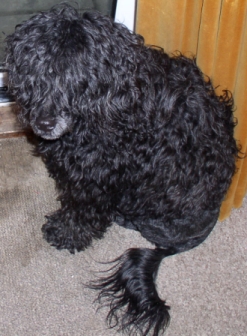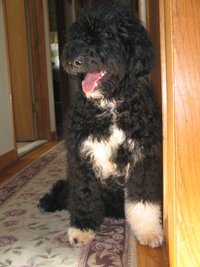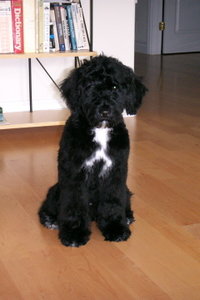
|
From Wikipedia the free encyclopedia, by MultiMedia |
| Portuguese Water Dog | ||
|---|---|---|

Portuguese Water Dog
|
||
| Alternative names | ||
| Cão de água Português | ||
| Country of origin | ||
| Portugal | ||
| Common nicknames | ||
| Portie, PWD | ||
| Classification and breed standards | ||
| FCI: | Group 8 Section 3 #37 | |
| AKC: | Working | |
| ANKC: | Group 6 (Utility) | |
| CKC: | Group 3 - Working Dogs | |
| KC (UK): | Working | |
| NZKC: | Utility | |
| UKC: | Gun Dog Breeds | |
| Not recognized by any major kennel club | ||
| This breed of Dog is extinct | ||
| Notes | ||
Portuguese Water Dogs are a breed of Dog, bred by the Portuguese to be companions at sea. They are similar in size to a Wheaten Terrier and are usually black but can also brown.
The hair is either worn in a "retriever cut" or a "lion cut." In the lion cut, the hindquarters, muzzle, and the base of the tail are shaved and the rest of the body is left full length. This cut originated with the fishing Dogs of Portugal to keep the body warm while allowing movement of the back legs. The end of the tail is kept long, because in those days, the fishermen sometimes didn't know how to swim, and the Dog could pull them to safety with its tail. The retriever cut is left 1" (2.5 cm) long evenly over the body (although some owners prefer the muzzle or the base of the tail shorter). This cut is a more recent style and originated because breeders wanted to make the breed more appealing and less unusual looking for buyers.
Most Dogs, especially traditional show Dogs, are entirely black or a dark brown; however, it is common to see white chests and legs on black and brown coats. "Parti" coats, with white fur and black spots, are rare but visually striking. The hair is either wavy or curly and is like human hair (and Poodle hair) in that it keeps growing. The hair must be trimmed about every two months and, although it is possible to groom at home, it is usually easier to pay a professional groomer. White hair is finer than black, and parti coat Dogs will require more frequent brushing and grooming to avoid matting.
Portuguese water Dogs have two coat types, wavy and curly. From the Portuguese Water Dog Club of America Revised Standard for the Portuguese Water Dog:
Occasionally, a Dog may have what is termed an "improper" coat. This is a cosmetic variation that relates to what is believed to be a recessive gene. It causes the Dog to have an undercoat (unlike curly- and wavy-coated PWDs), a flatter coat overall, and may have curling on the hocks, and generally appears more Spaniel- or Border Collie-like. Because these Dogs do not adhere to the breed standard, they may not be shown in competition, but otherwise are completely healthy and have all the excellent traits of PWDs. Some reports indicate that these coats shed more and are not hypoallergenic, although more study is needed. For more information on improper coats, see:
The Dogs also have an interesting bluish tinge to their skin that is hard to notice underneath their black fur. Their paws are slightly webbed, which one can see by trying to pass one's finger between the Dog's toes.
Portuguese Water Dogs make excellent companions. They are loving and sweet. Also, they are very intelligent. Since they are working Dogs, they are perfectly content in being at their master's side at all times. Owners of this breed will attest that their Portie follows them constantly. This is typical of the breed, as it strives for attention and prefers to be engaged in activity.
 Portuguese Water Dog of the Curly Coat Type
Portuguese Water Dog of the Curly Coat Type
Originating back to the 1500s in Portugal, Portuguese Water Dogs (Porties) were originally used by fishermen. They were used to send messages between boats, to retrieve fish and articles from the water, and to guard the fishing boats. (They often received a portion of the catch after a job well done, too!) They helped to bring in nets and to save fishermen when they fell in the water. They were very popular, and this might be where they picked up their loyal and dependable characteristics. Eventually commercial fishing equipment made the Dogs unnecessary. They fell out of favor and almost became extinct. At one point, there were only 25 Portuguese Water Dogs in the world. Since then, breeders have been carefully bringing back the breed. There are now thousands of Porties throughout the world.
The Portie is a fairly rare breed; only 15 entrants for Portuguese Water Dogs were made to England's Crufts competition in 2002, although their personality and nonshedding qualities have made them more popular in recent years.
When there is nothing else to do, Porties like to chew. Heavy-duty chew toys can help keep a Portie occupied.
 Portuguese Water Dog Puppy of the Wavy Coat Type
Portuguese Water Dog Puppy of the Wavy Coat Type
Portuguese Water Dogs have a multi-octave voice. Although they are not prone to barking excessively, they usually have a wide range of barks, chortles, grumbles and sighs. Porties also have an audible "laugh," a loud, irregular, breathy pant used at play or during greetings.
Dogs, made by MultiMedia | Free content and software
This guide is licensed under the GNU Free Documentation License. It uses material from the Wikipedia.